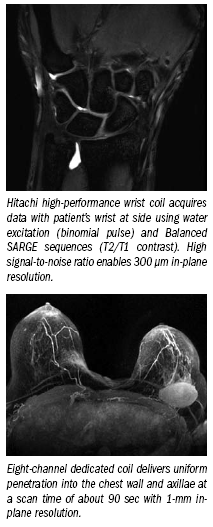Novel designs distinguish Hitachi's MRI scanners
Feet-first and ‘boreless’ magnets address clinical and patient comfort needs.
Hitachi strives to create a positive patient MRI experience without sacrificing clinical excellence. Our magnet designs and scanning features deliver needed clinical results while offering a comfortable scanning environment for anxious and bariatric patients.
Hitachi's latest products, the Echelon 1.5T and the Oasis 1.2T boreless imager, continue this tradition. Outpatient MR imaging providers have capitalized on the Hitachi product philosophy for many years, as it enables them to offer a differentiated and profitable imaging service to their communities. With their unique designs, our latest high-field products are problem-solvers for the highly competitive outpatient imaging market and, increasingly, for the hospital segment, as well.
Oasis, as a vertical-field boreless imager, is typical of Hitachi's traditional technological emphasis on open-sided architecture for optimal patient comfort and access. New for this architecture is Oasis' very high field strength. A Hitachi proprietary design delivers 1.2T field strength with extraordinary homogeneity: 0.3 ppm at 35-cm diameter of homogeneous spherical volume (VRMS). A six-channel active room-temperature shimming feature ensures uniformity for a broad spectrum of patient sizes (up to 660 pounds) and shapes, enabling excellent large to small field-of-view radiofrequency fat saturation. The symmetrical magnetic field also avoids any directional imaging constraint, delivering an isotropic 45-cm FOV.
The fast-gradient subsystem, eight-channel receiver, and sensitive proprietary Zenith RF coil technology take advantage of the high signal-to-noise ratio made available by Oasis' magnet, netting general image quality and spatiotemporal resolution on a par with 1.5T imagers.

Hitachi also deploys a powerful array of standard imaging features and enhancements to its high-field Oasis and Echelon products. The pulse sequences and image-processing capabilities expected of contemporary 1.5T scanners are in place, plus several unique features that further enhance our customers' (and their patients') MRI experience. One example is our Radar Motion Compensation Technique, which relies on the resampling of central k-space typical of the radial trajectory to compensate for patient physiological and gross motion. Radar delivers an entire motion-compensated study (T1, T2, T2*, FLAIR, fat-suppressed) in arbitrary planes and anatomy. It allows our users to scan ill, infirm, or anxious patients and obtain high-quality images, in many cases without suppression of swallowing or without a breath-hold.
Echelon 1.5T was introduced prior to Oasis and shares its imaging electronics. This cylindrical system is equipped with 150 T/m/sec slew-rate gradients, 16 or eight RF channel configurations, multicoil connectability, and the same array of imaging features and enhancements as Oasis. The workflow and image quality benefits of Echelon's advanced imaging platform combine with the patient comfort benefit of feet-first imaging for all studies, including brain.
Aside from a focus on the patient experience, Hitachi also invests heavily in providing regular no-charge software upgrades and unlimited follow-up applications support. For example, Oasis and Echelon customers have lately been provided with free-of-charge software upgrades (part of the UltraPlus Customer Support program), including important benefits to general MRI as well as breast and body MRI. Among other workflow and image quality enhancements, these upgrades deliver a multiaxis parallel imaging capability, as in the case of our Rapid 3D upgrade, which increases image quality and resolution for breast and body dynamic imaging, and our Radar T1 (spin-echo) and Radar T2/T1 (Balanced SARGE) features for complete motion-compensated studies.
Can Abbreviated MRI Have an Impact in Rectal Cancer Staging?
April 4th 2025Abbreviated MRI demonstrated a 95.3 percent specificity for rectal cancer and provided strong agreement with the full MRI protocol for T staging and detection of extramural venous invasion, according to newly published research.
Can Photon-Counting CT be an Alternative to MRI for Assessing Liver Fat Fraction?
March 21st 2025Photon-counting CT fat fraction evaluation offered a maximum sensitivity of 81 percent for detecting steatosis and had a 91 percent ICC agreement with MRI proton density fat fraction assessment, according to new prospective research.